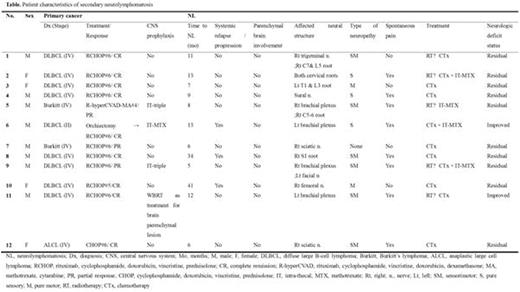Abstract
Traditionally believed to be a very rare condition, the reported incidence of neurolymphomatosis (NL) seems to be increasing. Nonetheless the diagnosis of NL remains challenging, especially in patients with refractory or relapsed hematologic malignancies, often leading to delayed or obscured diagnosis. Here, we describe our experience with secondary peripheral NL in non-Hodgkin lymphoma (NHL) patients, with the emphasis on the diagnosis process. A retrospective chart review was conducted in 3 tertiary academic centers in Korea from January 2005 to December 2015. A total of 12 patients were recognized, and we analyzed data including patient demographics, clinical history and presentations including the time lag between first symptom and treatment initiation, radiologic findings, serum tests, cerebrospinal fluid findings, results of electrodiagnostic studies, and biopsy analysis. The most common underlying lymphoma subtype was diffuse large B-cell lymphoma (75%, 9/12). NL occurred as a progressive disease during the first line of chemotherapy in 3 patients, and as a relapse of a previously treated disease in the remaining 9. Secondary NL was diagnosed within a median interval of 10 months (range 5-41 months) after initial diagnosis of NHL.Peripheral nerves were the most frequently involved site and NL affected more than one anatomic structure in 5 (41.7%) patients (Table). The diagnostic modalities included CSF analysis performed in 9 out 12 patients (75.0%), electrodiagnostic studies obtained in 7 out of 12 patients (58.3%), radiologic studies carried out for all patients, and nerve biopsy done in 2 patients (16.7%). The diagnostic yield of FDG-PET was high at 83.3% (10/12 patients). The diagnostic yield of MRI was 80.0% (8/10 patients). For those 2 patients in whom the imaging modality was not definitively diagnostic, nerve biopsy was carried out. Biopsy was performed from sural nerve and right sciatic nerve. In contrast to imaging modalities, CSF cytology and electrodiagnostic studies do not seem to be very useful in NL diagnosis. Painful neuropathy was present in 66.7% of our series, but the diagnosis of NL was delayed in 9 out of 12 patients (75.0%) by median of 2 months. In 2 patients, neuropathy was thought to be related to chemotherapeutic agents, while in 5 patients the cause was thought to be of inflammatory origins (2 with adhesive capsulitis, 1 with myofascial pain syndrome, 1 with postherpatic neuralgia, 1 with non-specific age related process, respectively).. Our experience emphasizes that the first step to timely recognition of NL in patients with previous history of NHL is a high index of clinical suspicion. Second step to diagnosis of NL would be choosing the diagnostic modality with the greatest clinical utility. Since PET scans are highly sensitive and at the same time can readily visualize both the peripheral and cranial nerve involvement as well as other tissue involvements, it seems to be the better imaging modality. In conclusion, with its increasing incidence, a high index of clinical suspicion is the first step to early diagnosis of secondary NL. Such clinical suspicion should be followed by timely use of subjective image modalities, preferably FDG-PET. Future studies are warranted to standardize the diagnosis process and optimize the therapeutic approaches to secondary NL.
No relevant conflicts of interest to declare.
Author notes
Asterisk with author names denotes non-ASH members.


This feature is available to Subscribers Only
Sign In or Create an Account Close Modal